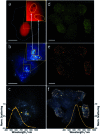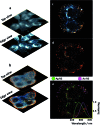Plasmonic labeling of subcellular compartments in cancer cells: multiplexing with fine-tuned gold and silver nanoshells
- PMID: 28451372
- PMCID: PMC5380877
- DOI: 10.1039/c6sc04127b
Plasmonic labeling of subcellular compartments in cancer cells: multiplexing with fine-tuned gold and silver nanoshells
Abstract
Fine-tuned gold and silver nanoshells were produced via an entirely reformulated synthesis. The new method yielded ultramonodisperse samples, with polydispersity indexes (PI) as low as 0.02 and narrow extinction bands suited for multiplex analysis. A library of nanoshell samples with localized surface plasmon resonances (LSPR) spanning across the visible range was synthesized. Hyperspectral analysis revealed that the average scattering spectrum of 100 nanoshells matched closely to the spectrum of a single nanoshell, indicating an unprecedented low level of nanoparticle-to-nanoparticle variation for this type of system. A cell labeling experiment, targeting different subcellular compartments in MCF-7 human breast cancer cells, demonstrated that these monodisperse nanoparticles can be used as a multiplex platform for single cell analysis at the intracellular and extracellular level. Antibody-coated gold nanoshells targeted the plasma membrane, while silver nanoshells coated with a nuclear localization signal (NLS) targeted the nuclear membrane. A fluorescence counterstaining experiment, as well as single cell hyperspectral microscopy showed the excellent selectivity and specificity of each type of nanoparticle for its designed subcellular compartment. A time-lapse photodegradation experiment confirmed the enhanced stability of the nanoshells over fluorescent labeling and their capabilities for long-term live cell imaging.
Figures








Similar articles
-
Hollow Gold-Silver Nanoshells Coated with Ultrathin SiO2 Shells for Plasmon-Enhanced Photocatalytic Applications.Materials (Basel). 2020 Nov 4;13(21):4967. doi: 10.3390/ma13214967. Materials (Basel). 2020. PMID: 33158286 Free PMC article.
-
In situ growth of hollow gold-silver nanoshells within porous silica offers tunable plasmonic extinctions and enhanced colloidal stability.ACS Appl Mater Interfaces. 2014 Nov 26;6(22):19943-50. doi: 10.1021/am505424w. Epub 2014 Nov 11. ACS Appl Mater Interfaces. 2014. PMID: 25321928
-
Imaging the uptake of gold nanoshells in live cells using plasmon resonance enhanced four wave mixing microscopy.Opt Express. 2011 Aug 29;19(18):17563-74. doi: 10.1364/OE.19.017563. Opt Express. 2011. PMID: 21935123 Free PMC article.
-
Theranostic nanoshells: from probe design to imaging and treatment of cancer.Acc Chem Res. 2011 Oct 18;44(10):936-46. doi: 10.1021/ar200023x. Epub 2011 May 25. Acc Chem Res. 2011. PMID: 21612199 Free PMC article. Review.
-
Engineered Gold Nanoshells Killing Tumor Cells: New Perspectives.Curr Pharm Des. 2019;25(13):1477-1489. doi: 10.2174/1381612825666190618155127. Curr Pharm Des. 2019. PMID: 31258061 Review.
Cited by
-
Silver Nanoshells with Optimized Infrared Optical Response: Synthesis for Thin-Shell Formation, and Optical/Thermal Properties after Embedding in Polymeric Films.Nanomaterials (Basel). 2023 Feb 3;13(3):614. doi: 10.3390/nano13030614. Nanomaterials (Basel). 2023. PMID: 36770575 Free PMC article.
-
Self-assembly of robust gold nanoparticle monolayer architectures for quantitative protein interaction analysis by LSPR spectroscopy.Anal Bioanal Chem. 2020 May;412(14):3413-3422. doi: 10.1007/s00216-020-02551-6. Epub 2020 Mar 21. Anal Bioanal Chem. 2020. PMID: 32198532 Free PMC article.
References
-
- Brito-Silva A. M., de Araujo C. B., Brayner F. A., Santos S. S., Galembeck A., Milet E. R. Polym. Eng. Sci. 2010;50:2350–2355.
-
- Brito-Silva A. M., Sobral-Filho R. G., Mejía H. A., Wang Y.-H., Wang P., Machado G., Falcão-Filho E. L., de Araújo C. B., Brolo A. G. J. Phys. Chem. C. 2014;118:18372–18376.
-
- Choi Y., Park Y., Kang T., Lee L. P. Nat. Nanotechnol. 2009;4:742–746. - PubMed
LinkOut - more resources
Full Text Sources
Other Literature Sources
Molecular Biology Databases
Research Materials
Miscellaneous

